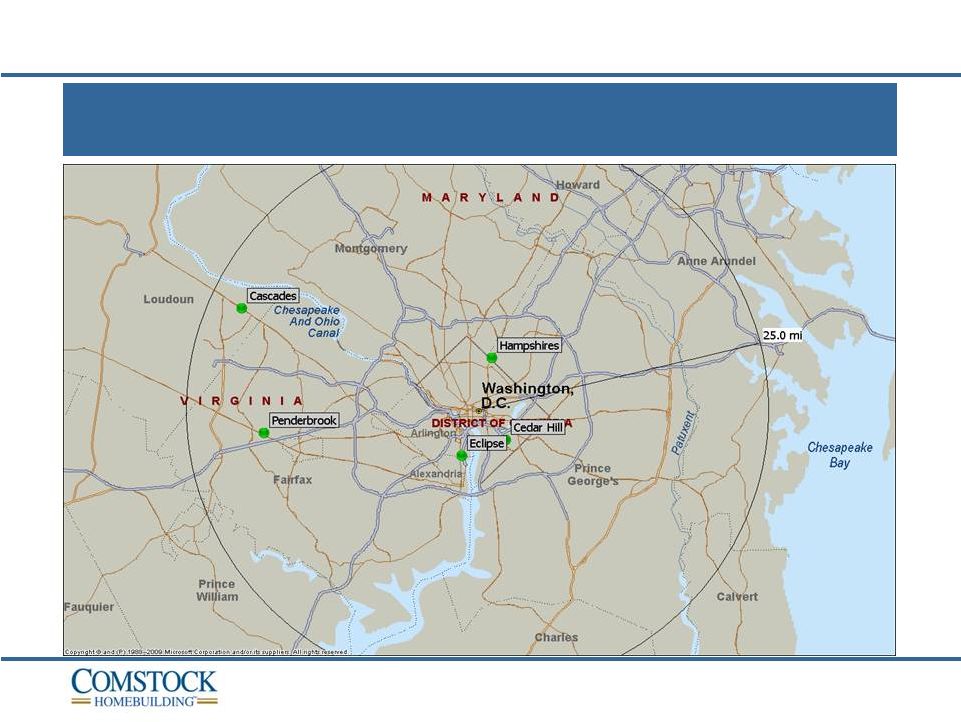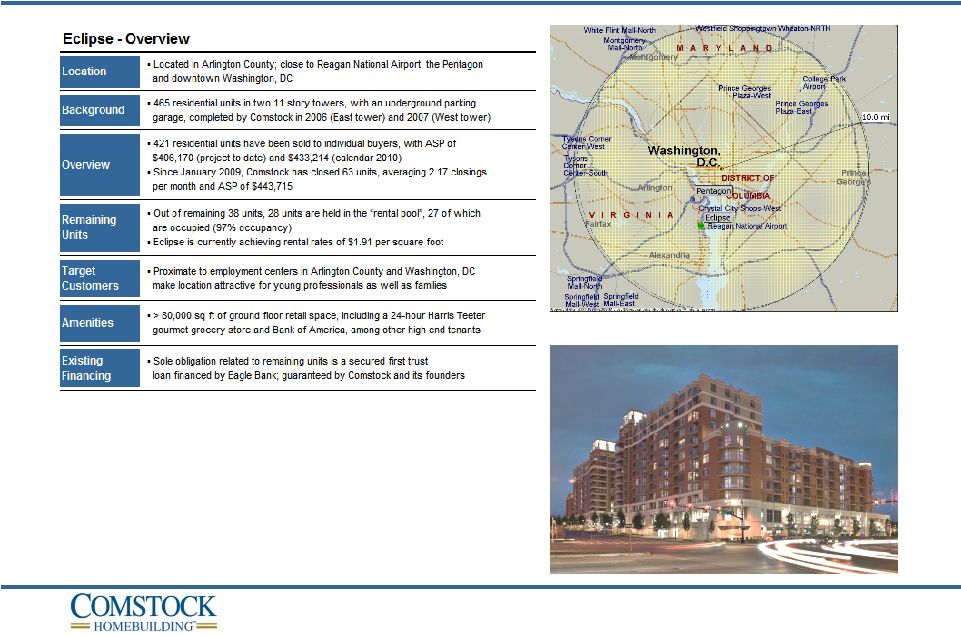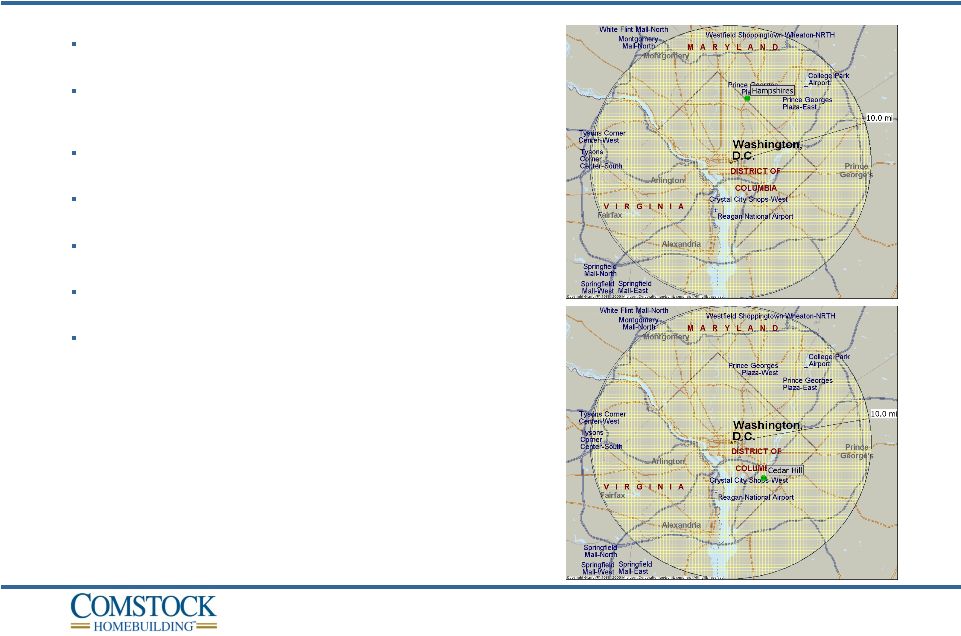Attached files
| file | filename |
|---|---|
| 8-K - FORM 8-K - Comstock Holding Companies, Inc. | d8k.htm |
 Investor Presentation
May 31, 2011
Exhibit 99.1
*
*
*
*
*
*
*
*
*
*
*
*
****************************** |
| Disclaimer
Certain
matters
discussed
throughout
all
of
this
presentation
constitute
forward-looking
statements
within
the
meaning
of
the
federal
securities
laws.
Generally,
our
use
of
words
such
as
“expect,”
“estimate,”“believe,”
“anticipate,”
“will,”
“forecast,”
“plan,”
“project,”
“assume”
or
similar
words
of
futurity
identify
statements
that
are
forward-looking
and
that
we
intend
to
be
included
within
the
Safe
Harbor
protections
provided
by
Section
27A
of
the
Securities
Act
and
Section
21E
of
the
Securities
Exchange
Act
of
1934.
Such
forward-looking
statements
are
based
on
management’s
current
beliefs,
assumptions
and
expectations
regarding
future
events,
which
in
turn
are
based
on
information
currently
available
to
management.
Such
statements
may
relate
to
projections
for
the
company’s
revenue,
earnings,
cash
flow
and
other
financial
and
operational
measures,
company
debt
levels,
and
future
operations.
We
caution
you
not
to
place
undue
reliance
on
any
forward-looking
statements,
which
are
made
as
of
the
date
of
this
presentation.
Forward-looking
statements
do
not
guarantee
future
performance
and
involve
known
and
unknown
risks,
uncertainties
and
other
factors.
Several
factors
could
cause
actual
results,
performance
or
achievements
of
the
company
to
differ
materially
from
those
expressed
in
or
contemplated
by
the
forward-looking
statements.
Such
risks
include,
but
are
not
limited
to,
changes
to
general,
domestic
and
foreign
economic
conditions
and
operating
risks
common
in
the
real
estate
and
homebuilding
industries.
These
and
other
risk
factors
are
discussed
in
detail
in
the
Risk
Factors
section
of
the
company’s
Form
10-K
for
the
year
ended
December
31,
2010,
filed
with
the
Securities
and
Exchange
Commission.
We
undertake
no
obligation
to
publicly
update
or
revise
any
forward-looking
statement,
whether
as
a
result
of
new
information,
future
events
or
otherwise.
1 |
 Investment
Thesis
–
Why
Comstock?
Unique “story”
in the publicly traded real estate space
Experienced
real
estate
management
team
operating
through
a
publicly
traded
business
platform
Deep knowledge of target Washington DC market; proprietary deal flow
No
significant
“legacy”
issues
as
is
common
in
the
industry
-
not
encumbered
by
large
land
holdings
or
unfinished communities
Restructured balance sheet
Rationalized cost structure
$12.5
million
pending
award
judgment,
when
collected,
will
provide
additional
growth
capital (assuming the
pending appeal of the award is concluded in a manner favorable to us)
$72
million
of
available
NOL’s
that may
potentially
offset
future
taxable
income
Significant
insider
ownership
and
sponsorship
2 |
 Comstock Overview
We
are
a
multi-faceted
real
estate
development
and
services
company
with
substantial
experience
in
building
a
diverse
range
of
products
including
single-family
homes,
townhomes,
mid-rise
condominiums,
high-rise multi-
family
condominiums
and
mixed-use
(residential
and
commercial)
developments.
Since
our
founding
in
1985,
and
as
of
December
31,
2010,
we
have
built
and
delivered
more
than
5,200
homes
generating
revenue
in
excess
of
$1.3
billion.
In
December
2004,
we
completed
our
initial
public
offering
(NASDAQ:CHCI).
In
2005,
we
began
executing
expansion
plans
and
established
operations
in
key
markets
throughout
the
Southeast.
Notably,
during
2006
we
increased
revenues
to
$266
million.
However,
during
2007
it
became
clear
that
the
unprecedented
span
of
growth
in
the
housing
sector
was
quickly
ending.
Drawing
on
the
valuable
experience
our
management
team
had
gained
in
previous
downturns,
we
expeditiously
curtailed
expansion
plans
and
adopted
a
defensive
strategy
that
allowed
us
to
survive
the
housing
downturn.
We
quickly
sold
certain
assets
and
worked
closely
with
our
existing
lenders
to
amicably
renegotiate
the
terms
of
project
related
and
corporate
borrowings,
which
had
peaked
at
$340
million
as
of
September
30,
2006.
In
2009,
we
established
our
Strategic
Realignment
Plan
(the
“Strategic
Realignment
Plan”).
The
Strategic
Realignment
Plan
was
designed
to
eliminate
debt,
further
reduce
expenses,
enhance
our
balance
sheet,
conserve
cash,
and
protect
key
Washington,
D.C.
market
assets.
By
the
end
of
2009,
we
had
successfully
renegotiated
substantially
all
of
our
secured
debt
obligations
and
reduced
total
debt
to
$68
million
($
28.4
million
as
of
December
31,
2010).
We
believe
that
having
achieved
the
major
objectives
of
the
Strategic
Realignment
Plan
(which
eliminated
or
reduced
corporate
and
project
related
debt
while
disposing
of
noncore
assets
where
market
values
had
deteriorated)
ultimately
allowed
for
the
retention
of
core
assets
in
the
Washington,
D.C.
market.
3 |
 Our
Operating Market – Washington, DC
We
are
exclusively
focused
on
the
Washington,
D.C.
market
which
is
the
eighth
largest
metropolitan
statistical
area
in
the
United
States.
Our
expertise
in
developing
traditional
and
non-traditional
housing
products
enables
us
to
focus
on
a
wide
range
of
opportunities
within
our
core
market.
We
have
built
homes
and
apartment
buildings
in
suburban
communities,
where
we
focus
on
low
density
products
such
as
single
family
detached
homes,
and
in
urban
areas,
where
we
focus
on
high
density
multi-family
and
mixed
use
products.
For
our
homebuilding
operations,
we
develop
properties
with
the
intent
that
they
be
sold
either
as
fee-simple
properties
or
condominiums
to
individual
unit
buyers
or
as
investment
properties
sold
to
private
or
institutional
investors.
Our
apartment
buildings
are
developed
as
rental
properties
to
be
held
and
operated
for
our
own
purposes,
converted
at
some
point
to
for-sale
condominium
units
or
sold
on
a
merchant
build
basis.
We
target
first-time,
early
move-up,
and
secondary
move-up
buyers
with
our
homebuilding
product.
We
focus
on
products
that
we
are
able
to
offer
for
sale
in
the
middle
price
points
within
the
markets
where
we
operate,
avoiding
the
very
low-end
and
high-end
products.
We
believe
our
middle
market
strategy
positions
our
products
such
that
they
are
affordable
to
a
significant
segment
of
potential
home
buyers
in
our
market.
We
believe
that
our
significant
experience
over
the
past
25
years,
combined
with
our
ability
to
navigate
through
two
major
housing
downturns
(early
1990’s
and
late
2000’s)
have
provided
us
the
experience
necessary
to
capitalize
on
attractive
opportunities
in
our
core
market
of
Washington,
D.C.
and
to
rebuild
shareholder
value.
We
believe
that
our
focus
on
the
Washington,
D.C.
market,
which
has
historically
been
characterized
by
economic
conditions
less
volatile
than
many
other
major
homebuilding
markets,
will
provide
an
opportunity
to
generate
attractive
returns
on
investment
and
for
growth.
4 |
| Comstock’s Business Plan
*
*
*
*
*
*
*
*
*
*
* |
 Our
Business Strategy Our
business
strategy
is
designed
to
leverage
our
extensive
capabilities
and
market
knowledge
to
maximize
returns
on
invested
capital
on
our
various
real
estate
related
activities.
We
execute
our
strategy
through
three
related
business
units:
•
Homebuilding
–
We
target
new
home
building
opportunities
where
our
building
experience
and
ability
to
manage
highly
complex
entitlement,
development
and
distressed
assets
provides
us
with
a
competitive
advantage.
•
Apartments
–
We
seek
opportunities
in
the
multi-family
rental
market
where
our
experience
and
core
capabilities
can
be
leveraged.
We
will
either
position
the
assets
for
sale
to
institutional
buyers
when
completed
or
operate
the
asset
within
our
own
portfolio.
Operating
the
asset
for
our
own
account
affords
us
the
flexibility
of
converting
the
units
to
condominiums
in
the
future.
•
Real
Estate
Services
–
Our
management
team
has
significant
experience
in
all
aspects
of
real
estate
including
strategic
planning,
land
development,
entitlement,
property
management,
sales
and
marketing,
workout
and
turnaround
strategies
and
general
construction.
We
provide
a
wide
range
of
construction
management
and
general
contracting
services
to
other
property
owners.
This
business
line
not
only
allows
us
to
generate
positive
fee
income
from
our
highly
qualified
personnel
but
also
serves
as
a
potential
catalyst
for
joint
venture
and
acquisition
opportunities.
These
business
units
work
in
concert
and
leverage
the
collective
skill
sets
of
our
organization.
The
talent
and
experience
of
our
personnel
allows
workflow
flexibility
and
a
multitasking
approach
to
managing
various
projects.
In
a
capital
constrained
environment,
we
use
creative
problem
solving
and
financing
approaches
by
working
closely
with
banks,
borrowers
and
other
parties
in
an
effort
to
generate
value
for
all
constituents.
We
believe
that
our
business
network
within
the
Washington,
D.C.
real
estate
market
provides
us
a
competitive
advantage
in
sourcing
and
executing
investment
opportunities.
6 |
 7
Comstock Concentrated Approach
Three Business Lines Concentrated In One Favorable Market
Washington,
D.C.
Metropolitan
Area
–
Among
Best
Performing
Real
Estate
Markets |
| Current
Projects *
*
*
*
*
*
*
*
*
*
*
* |
 9
Comstock Communities
The strength of the Washington, DC economy, increased demand for rental housing and
stabilizing conditions in the new home market provides an attractive opportunity to
maximize the value of each Comstock development
|
 10
Penderbook (Penderbrook Square) |
 11
Eclipse (The Eclipse on Center Park at Potomac Yard) |
 12
Cascades (The Commons on Potomac Square) |
 13
Hampshires and Cedar Hill
The
Hampshires
and
Cedar
Hill
will
be
developed
as
a
result
of
a
joint
venture
between
Comstock
and
Four
Points,
LLC
Four
Points,
LLC
is
contributing
the
land
and
Comstock
will
manage
the
onsite
development,
construction
and
marketing
of
the
projects,
as
well
as
project
financing
The
Hampshires
is
located
in
close
proximity
to
2
Metro
stations
in
Northeast
Washington,
DC
Cedar
Hill
is
located
in
the
southeast
Washington,
DC,
near
the
home
of
the
Washington
Nationals
baseball
team
Comstock
plans
to
commence
site
improvements
and
construction
on
both
communities
as
soon
as
final
permits
are
obtained,
expected
in
2011
The
Hampshires
will
include
37
single
family
detached
homes
and
73
townhomes
Cedar
Hill
will
include
a
40
units,
including
1
single
family,
7
townhomes
and
32
townhome
style
condominiums |
 Improved Financial Position |
 Financial Restructuring –
Significant Improvement in Overall Financial Position
Comstock has restructured its balance sheet
Reduced debt load from a peak of over $340 million to less than $30 million in
2011 Only maturity in 2011 is $6.2 million Penderbrook secured loan which we
believe we have the ability to refinance
Eclipse secured $12 million loan was successfully refinanced Eclipse in February
2011 New lending relationship created with closing of $11 million
construction/permanent loan for the Cascades 103 unit apartment development
in February 2011 Management routinely explores additional debt and equity
financing opportunities that could enhance Comstock’s ability to
enhance results and shareholder value Comstock has restructured its
operations Significant reductions in overhead: streamlined operations
Selling, general and administrative expenses down from $37.5 million in 2006 to
$5.6 million in 2010 Experienced real estate management team remains with
diverse financial and operating backgrounds Management has reinvested in the
business Senior management has significant capital invested in the business,
including recent investments Recent capital raise for newly constructed
Cascades apartment project has significant inside equity ownership
15 |
 Well
Positioned For Return To Profitability Focused
on
Washington,
DC
market,
widely
regarded
as
best
real
estate
market
in
nation
Experienced
management
team
with
unique
operating
model,
ability
to
develop
wide
range
of
housing
products,
including
single
family
homes
in
suburban
areas
to
mixed-use
and
high
density
products
in
urban
areas
where
high
density
products
are
favored
Positioned
to
quickly
and
effectively
identify,
pursue
and
execute
against
strategic
opportunities
Key
assets
(Eclipse
and
Penderbrook)
provide
cash
flow
to
support
operating
activities
Creating
new
value
through
new
business
units
(rental
apartments
and
contracting/real
estate
services)
Eclipse
judgment
award
(approximately
$12.5
million),
when
collected,
will
provide
additional
growth
capital
(assuming the pending appeal of the award is concluded in a manner favorable to
us) Comstock
has
deferred
tax
asset
of
NOL’s
that
is
estimated
to
be
$72
million
gross
or
$27
million
of
tax
savings
(subject
to
IRC
sec.
382
limitations) which may be available to offset future taxable income
16 |
 Conclusion |
 Why
Comstock Is Positioned To Rebuild Its Business And Increase Shareholder Value
While
the
national
housing
recovery
continues
to
seek
solid
footing,
Comstock’s
focus
on
the
Washington,
DC
market
and
its
diverse
real
estate
development
platform
provides
opportunities
to
build
its
business,
increase
revenues,
and
return
to
profitability
Comstock’s
single
market
focus
is
on
the
strongest
real
estate
market
in
the
nation
Job
growth
in
the
Washington
region
continues
to
outpace
national
trends,
causing
unemployment
rate
to
be
among
the lowest
in
the nation
while
regional
per
capita
income
continues
to
be
among
highest
in
nation
Population
growth
follows
job
growth,
adding
stability
to
the
Washington,
DC
housing
market
Housing
demand
and
price
stability
in
the
Washington,
DC
area
continues
to
outpace
national
trends
Housing
affordability
is
high
due
to
low
mortgage
rates
and
reduced
prices,
but
mortgage
financing
is
challenging
for
many,
leading
to
increased
demand
for
quality
rental
housing,
occupancy
rates
among
highest
in
nation,
and
increasing
rental
rates
Recent
demographic
shifts
and
high
transportation
costs
are
increasing
demand
for
new
housing
in
close-
in,
urban
areas
where
mixed-use
and
high
density
housing
is
favored
Comstock’s
diverse
capabilities
and
“Real
Estate
Opportunity
Fund”
approach
enables
it
to
adapt
to
changing trends in housing and capitalize on attractive opportunities
Our
experience
successfully
navigating
two
major
housing
industry
downturns
(early
1990’s
&
late
2000’s)
provides
invaluable
insight
to
market
cycles
and
shifts
in
housing
demand
in
the
Washington,
DC
region
Our
experience
developing
a
diverse
range
of
housing
products
(from
suburban
single
family
homes
to
urban,
mixed-use
and
high
density
buildings)
provides
Comstock
significant
competitive
advantages
Our
new
community
development
strategy
ensures
Comstock
assets
are
positioned
to
capitalize
on
demand
for
rental
properties
and
for-sale
properties
Management
believes
it
will
succeed
in
rebuilding
shareholder
value
in
the
near
term utilizing limited
capital resources.
Given
our limited
share
universe,
our
cash
flow
“backlog”
and
tax
attributes
($72M+
NOL’s),
our
earnings
per share
are
highly
sensitive
to
relatively
small
EBITDA
increases.
18 |
